Abandoned Cart Email Subject Lines (27 Strategies + Examples)
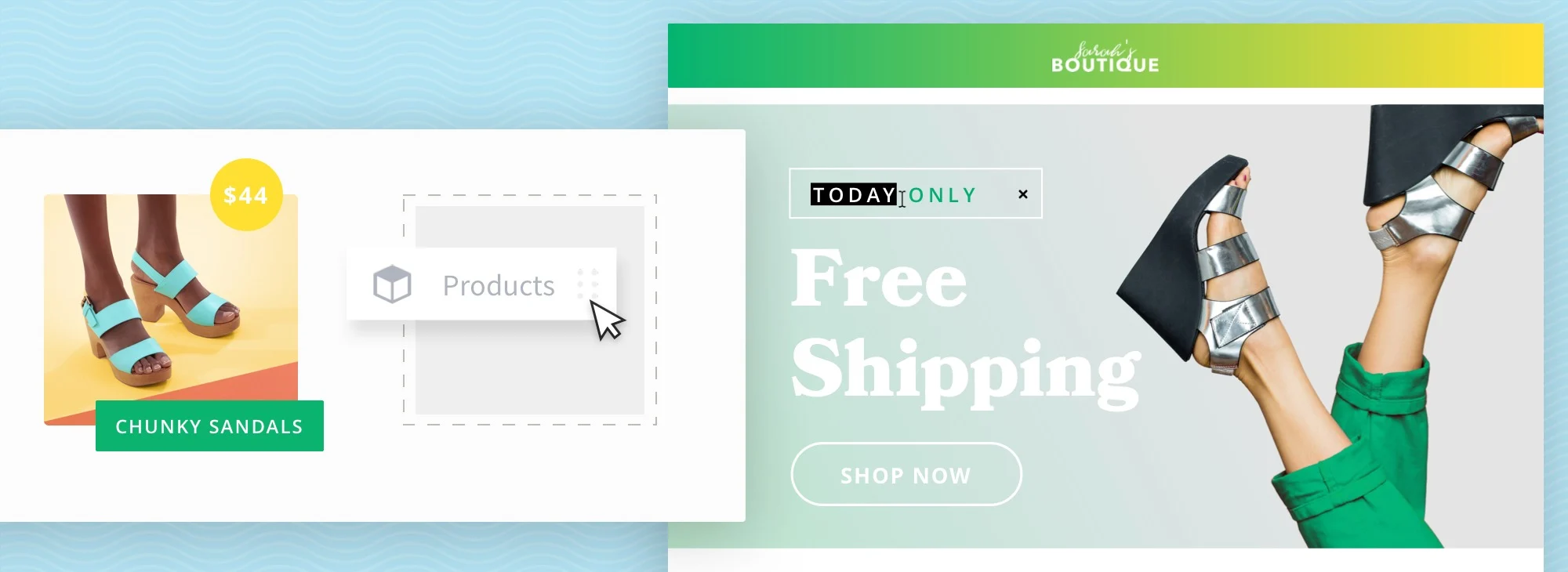
When was the last time you thought to yourself, “Oh look, I only have a few emails today! Let me open all of them real quick”?
Probably never… at least if your inbox looks anything like most people’s inboxes.
Last year alone, roughly 281 billion emails were sent and received every day. And that number is expected to increase to 347 billion daily mails in 2022, according to Statista.
That’s a lot of noise to cut through, which is exactly why your abandoned cart email subject lines are so important.
Abandoned shopping cart emails are a powerful tool brands can use to convert shoppers who’ve expressed an interest in a product, but who haven’t yet finished their checkouts.
The stakes are high for your abandoned cart subject lines, though.
If they fail to get people to open your emails, you leave money on the table.
But if they do their job and people open your emails, you have a much better chance of getting shoppers to click through, finish their purchase, and capture more revenue for your brand.
Read on to learn more about:
Why you should send cart abandonment emails to everyone who shops on your site.
Why your subject lines are essential.
Tips to create subject line copy that converts, plus a common pitfall to avoid.
Types of subject lines you can test, plus sample copy.
Different ways you can test your subject lines.
Strategies to segment your abandoned cart emails.
Examples of awesome subject lines from real merchants.
Why You Should Send Abandoned Cart Emails to Everyone Who Shops on Your Site
Before we get into subject line specifics, let’s talk about what they’re attached to — abandoned cart emails.
Abandoned cart emails help you connect with people who were once engaged with your brand and gently nudge them through the virtual checkout line.
Considering nearly 70% of online carts get abandoned, according to Statista, these emails should be part of any ecommerce marketer’s email mix. After all, that’s a lot of money to leave on the table. But just how much?
Over the span of just three months, for nearly 3,000 brands, it added up to more than $60 million dollars, according to Klaviyo’s data.
Researchers analyzed more than 3,100 abandoned cart emails that were sent to nine million email addresses and the results showed that sending timely, relevant emails is well worth the effort. It’s also something you can easily automate.
As you think about setting up a series of abandoned cart emails, keep in mind the many different reasons people abandoned their carts.
Some people simply aren’t ready to buy. Others get distracted and forget to follow through with their purchase. Many are price-sensitive and like to shop around to compare prices or look for better deals. Others browse on a mobile device and plan to make a purchase on their desktop, but then forget. Some don’t have a credit card handy. The list goes on.
Shopping cart abandonment happens for lots of reasons, but the most common ones, according to Statista, include:
Shipping costs too much (63%).
Discount code doesn’t work (46%).
Order takes forever to ship (36%).
Have to re-enter credit card info (30%).
Have to re-enter shipping info (25%).
Whatever the actual reason someone abandons a cart on your site, it’s most likely not because they’re no longer interested in your products.
With a little proactive persistence, marketers can use cart abandonment emails to convert shoppers, capture revenue they’d otherwise lose, and build relationships with more customers.
But many marketers struggle with one of the most important components of an abandoned cart email: the subject line.
“Abandoned Cart Subject Lines Are Essential” — The Data
Subject lines are directly tied to your email open rates, so the ones you write for your abandoned cart emails can make or break your efforts to convert customers.
Your abandoned cart emails could have the most compelling offer, the most eye-catching creative, the cleverest copy. Yet none of that matters if your emails go unopened.
On any given day, people are inundated with messages and notifications. Work emails, personal emails, text messages, Slack notifications, social media notifications… it never seems to end.
How can you get your message to cut through all the noise?
How will you stand out in a sea of notifications and daily distractions?
How will you keep your brand from being buried in the eternal depths of an inbox?
It all starts with your subject line.
With abandoned cart emails specifically, subject lines that simply remind someone that they left something behind tend to perform best, according to Klaviyo’s research.
These emails had a higher open rate than average (47.67%vs. 41.18%, respectively).
Emails with emojis in their subject lines performed slightly lower than average (39.09%), though the difference is minimal enough that brands can still afford to test whether emojis will resonate with their own audiences.
Emails that mentioned discounts in the subject line — either with a percentage or dollar sign or the words “free shipping” — had a slightly lower open rate than average (38.31%), yet their average click rate was nearly 11%.
Let’s explore some specific strategies you can use to create subject line copy that gives your customers a reason to open your emails.
7 Tips To Create Abandoned Email Cart Subject Line Copy That Converts + 1 Common Pitfall to Avoid
Writing subject lines that are simple, clear, and to the point (and maybe a little clever, depending on your audience) will help you pique your customers’ interest.
In this section, we’ll take a look at seven strategies to help you create copy that boosts your conversion rate, plus a common pitfall to avoid.
(Spoiler alert: in the next section, we’ll dig into different types of subject lines, plus sample copy, you can test that use one or more of the following tips.)
1. Keep your subject lines simple.
Remember the goal of your abandoned cart email subject line. Its whole job is to simply get people to open your email.
When you’re competing for your shoppers’ attention, not only should your messages be compelling, but they should also be simple, direct, and to the point.
Instead of a subject line like:
Your favorite jeans are almost gone! Get 10% off, plus check out these items we think you’ll love!
Try something like:
Get your new favorite jeans before they’re gone!
This version conveys the main idea with a sense of urgency in a simple, succinct sentence.
To entice people to open your emails, keep your subject lines to one specific message. Then, use the body of your email to get shoppers to click through to your site to ultimately make their purchase.
2. Keep your subject line copy short.
Lots of factors can influence the ideal length for your abandoned cart email subject lines. What type of device is someone reading it on? How have your past subject lines performed? What has your audience previously responded to?
If you’re not sure what will work well, your best bet is to test, test, and test some more.
That said, there’s one golden rule: less is more.
Normally, if someone reads your email on a desktop computer, they’ll see about 60 characters of your subject line before the rest gets cut off. But if someone reads your email on a mobile device, that number drops to 25-30 characters. Keep your subject lines as short as possible so readers see your whole message.
Instead of this subject line:
[Katie], we noticed you were shopping on our site and you left some items behind in your cart! {95 characters}
Try something like:
[Katie], you forgot something! {30 characters}
Still worried your message might get cut off? If you can’t trim or tighten your copy any more, keep the most compelling parts of your message toward the beginning of your subject line so recipients get the main idea.
3. Personalize your message.
Shoppers today are demanding more from brands.
People no longer have to put up with impersonal, transactional businesses. They have more choices than ever, and they’re increasingly choosing to engage with brands that provide value and are authentic — brands they trust.
A little personalization goes a long way toward developing relationships that lead to long-term value for both you and your customers. And it pays to personalize your emails.
Companies that personalize their emails saw a 17% increase in revenue, according to research by OneSpot and The Relevancy Group.
So how do you specifically personalize your cart abandonment email subject lines? Let’s take a look at some of the simple and short subject lines from the last section.
This specific subject line references the particular item I placed in my cart.
Get your new favorite jeans before they’re gone!
Being as specific as possible is best, but if you’re short on time and resources, you can start by referencing the broader category an item belongs to and then get more specific as you test and refine your subject lines. Here’s an example:
Get your new favorite pants before they’re gone!
This next subject line uses the shopper’s first name as a personalization technique.
[Katie], you forgot something!
Including your shopper’s first name in your subject line allows you to speak directly to them and make them feel like their experience with your brand is unique.
4. Make your subject lines compelling.
Compelling doesn’t mean, “BUY NOW!” or “BIG SALE!”
Messages like these can be too aggressive for many people.
Rather, a compelling offer is one that gives someone a reason to open your email and shop from your brand. And you don’t always have to offer a discount to make your offer compelling.
You can create compelling offers by highlighting the quality of your products, demonstrating how easy it is to shop on your site and make a purchase, showing what’s different about the experience you offer, or creating a sense that someone might miss out on something if they don’t open your email.
Spatulas are selling fast – don’t miss out!
Discounts are compelling, too, but be careful about offering them with your first abandoned cart email, which could lead you to lose money unnecessarily. Instead, segment your list and send relevant messages to each group.
For repeat customers, consider giving them a gentle reminder about their cart or creating a sense that they’ll soon miss out on items that are selling fast. If that doesn’t work, try including a discount with the second or third email in your abandoned cart series.
For first-time shoppers, a discount on their first purchase may actually work quite well.
Take 10% off your first purchase!
Use your email copy to show these first-time customers that they’re getting a discount because they’re making their first purchase. This way, they don’t begin to expect coupons for every subsequent purchase they might make.
Compelling offers are effective, but get creative and use discounts strategically.
5. Create curiosity.
Curiosity may have killed the cat, but it’s also converted a lot of shoppers.
You can create a sense of curiosity with your abandoned cart subject lines in many ways. Subject lines that are written as a question, for example, get people thinking.
Did you leave something behind?
This encourages people to remember their recent experience with your brand and think back to items they added to their carts.
Subject lines that end with an ellipsis (…) can also pique curiosity and often function as a cliffhanger.
I think you left something behind…
This gets readers thinking and wondering about what they might have forgotten. The ellipsis demonstrates that the answer might be in the email, so it encourages readers to open it to learn more.
6. Make your subject lines visually interesting.
Have you ever seen a subject line that looks like this?
+++TODAY ONLY+++20% OFF SALE!!!!!!!!!!
I have. And it’s not good. It’s visually an eyesore. It’s aggressive in tone (I think, “why are you yelling at me?!”). It’s confusing (why are the + signs there?). And it can leave readers wondering what the rest of the email looks like if this is the subject line.
This one goes overboard with the exclamation points, but those aren’t all bad. In fact, exclamation points can convey excitement and spur action… if you use them sparingly.
The same research by Klaviyo found subject lines with a single exclamation point saw a slightly higher than average open rate (42.35% — a 1.17% boost). But the messages that used more than one exclamation point saw their open rates plummet to 36%.
Too many exclamation points can also trigger spam filters and hurt your email deliverability. You’re better off having just one exclamation point in your subject line if you want to use them.
Instead of the subject line above, try something like this:
Take 20% off your purchase! Today only.
This message communicates a sense of excitement about the offer (the single exclamation point) and clearly conveys a sense of urgency (today only).
7. Create urgency… but use it sparingly and avoid this one common pitfall.
Creating a sense of urgency is a great way to drive action. But unless you’re thoughtful and strategic, this approach can backfire. Here are some sample subject lines to tread lightly with:
Limited time only
While this seems like it would cause someone to act, data shows it actually has a counter-effect. More than 100 brands used this subject line and saw open rates of 29.3% — more than 10% less than average, according to Klaviyo’s data.
The problem? It’s too vague. How limited is the limited time? Is the offer limited to today, this weekend, this month?
Shoppers need specifics to be compelled to act. Vague subject lines tend to encourage inaction rather than action.
Last chance OR About to expire
Messages like this are also vague. When will something expire? By when do I have to act on this last chance you’re giving me?
With abandoned carts, the more time that passes, the less likely shoppers are to return to their carts, so vague messages often do little to convince people to buy.
24 hours left
This one isn’t vague. But this message, like the others above, puts pressure on the shopper. Many people don’t like that, which is seen in the lower than average open rates these messages tend to generate.
Instead of pressure-based messages, try a simple reminder:
[Katie], you left some items in your cart
Use these simple strategies as the foundation for your subject line copy. Then, start experimenting with the different types of subject lines we’ll cover in the next section to see what will work well for your audience.
5 Types of Subject Lines To Test (Plus Sample Copy)
Now that you have some tips to create subject line copy that converts, let’s spark some inspiration by exploring a few types of subject lines that use one or more of the strategies covered in the previous section.
1. Simple, direct subject lines.
These subject lines are effective because they’re easy to understand and they’re quick to read.
You can create simple, direct subject lines through the use of a statement (e.g., You left something behind.), a question (e.g., Forget something?), creating a sense of missing out on something (e.g., Don’t miss out!), or by creating a cliffhanger through the use of an ellipsis (e.g., It looks like you left something behind…).
Here are 10 examples of simple, direct subject lines.
You forgot something.
A simple reminder…
Reminder: you have items in your cart
There are still items left in your cart
Still thinking it over?
Ready to make your purchase?
Need help making a decision?
What can I help you with?
Get the items in your cart before they sell out!
The items in your cart are going, going…
2. Gentle reminders.
It’s easy for shoppers to get distracted and forget they were just about to make a purchase (guilty!). Sometimes a little reminder can be all it takes to bring shoppers back to their carts. And reminder messages work really well, as the data showed earlier.
Here are eight examples of subject lines that include gentle reminders in the copy:
Oops… you left something in your cart!
Leave something behind?
Did you forget something?
You left some items in your cart.
Forget to check out?
You’re so close!
Oh no! You left something behind.
Your cart misses you!
3. Personalized subject lines.
Let’s take those simple and gentle subject lines one step further and personalize them.
There are lots of ways you can personalize your abandoned cart email subject lines: use your subscriber’s first name, mention a particular item they added to their cart, show them how easy it is to complete their purchase, and more.
Say I was recently shopping on your site and I added a pair of jeans to my cart. Here are 12 sample subject lines that are personalized specifically for me:
[Katie], you left something at checkout!
You left some super comfy jeans behind…
Hey [Katie]! You left something behind…
Hey [Katie], you forgot something.
Did you forget something, [Katie]?
Did you like the jeans you were checking out?
Still deciding, [Katie]?
Ready to complete your purchase, [Katie]?
[Katie], get your new favorite jeans in [X] clicks!
[Katie], get your new jeans in time for the weekend!
[Katie], complete your purchase in [X] clicks!
[Katie], stay in style in your new jeans!
Don’t have your subscriber’s first name? Create a default setting. Something as simple as adding “Hey there!” before your message comes across as conversational and a bit more personal than a generic message. Companies that used this default setting saw open rates of 52%, according to Klaviyo’s research.
But be careful: don’t get overly friendly with someone if you don’t know their name. Things like, “Hey friend!” can come across as a bit off-putting to some people.
4. Compelling offers.
Offering some type of incentive is often an effective way to encourage people to make a purchase, particularly with first-time customers.
Here are 10 examples of subject lines that feature a compelling offer.
Here’s [$X] on us
Hi [Katie], would [X%] off help?
Hey [Katie], how about [X%] off?
[Katie], get free shipping today with your purchase!
See the new low price on something in your cart!
Come back and get [X%] off items in your cart!
[Product] is almost sold out!
Take [X%] off your first purchase.
Your first order ships free!
Your next order ships free!
Remember to use your incentives strategically, though.
If you’re sending an email to a customer who’s previously purchased from you, it may not be necessary to offer a discount with your first abandoned cart email. You could save that for the final email in your abandoned cart series, and instead start with something like a gentle reminder since they’ve already engaged with your brand.
For first-time customers, it may be more effective to include an offer for free shipping or a certain percentage off their first order. Many brands do this with a specific time restriction (e.g., This week only, get 10% off your first order!)
5. Write creative copy related to your products or industry.
All of the examples above illustrate different techniques you can try with your subject lines, but don’t forget to be creative! Add some personality to your emails by writing copy that’s relevant to either the products you’re selling or the industry you serve.
Here are six examples of creative copy:
Beauty: Keep your summer glow with free shipping!
Fashion: [Katie], stay in style with the items in your cart!
Home: Don’t be left in the dust. Scoop up [X%] off items in your cart!
Garden: Plant today, grow tomorrow with items in your cart.
Food: Getting hangry? Your snacks are in your cart.
Fitness: [Katie], tread well with your new sneakers!
No matter which types of subject lines you use, it’s important to regularly test and refine your message. What works today might not work next month, next quarter, or next year. Marketers who consistently test and optimize their messages are the ones who will drive the best results.
3 Ways to A/B Test Your Abandoned Cart Emails
Abandoned cart emails will help you make more money. And now that you know the strategies behind creating copy that converts and the types of subject lines you can A/B test, you can design some experiments to figure out which messages will resonate best with your audience.
Not familiar with A/B tests? They’re a simple yet effective way to get some data on what works for your brand. You basically create two versions of a component of your email (the subject line, for example) and test them against each other to see what works best (subject line A or subject line B).
When designing your A/B test, the most important thing to do is test one thing at a time (i.e., when you test your subject lines, just test your subject lines and nothing else within the email itself).
Here are three ways to A/B test your abandoned cart emails:
Test your subject lines.
Test how many emails you send.
Test when you send your emails.
1. Test your subject lines.
A common question marketers ask is, “What will get people to open my emails?”
Figuring out which messages will work best is a critically important part of making sure your abandoned cart emails work as well as they can for your business.
Try different variations of your subject lines. For example, see if a gentle reminder sparks more open rates or if a compelling offer does the trick.
Variation A: [Katie], it looks like you left something behind.
Variation B: The [product] in your cart is almost sold out!
If you find the gentle reminder works best, try different variations of your gentle reminder next.
Variation A: [Katie], it looks like you left something behind.
Variation B: Forget something, [Katie]?
Does the straightforward statement perform better or does the question format win?
If you find the statement works best, try testing how you style your copy next.
Variation A: [Katie], it looks like you left something behind.
Variation B: [Katie], it looks like you left something behind!
This subject line is almost exactly the same, but it’s been styled slightly differently. Notice the period at the end of the first variation and the exclamation point at the end of the second variation. There are lots of ways to style your subject lines—use bold text, brackets, emojis, symbols, etc.
The best way to know what will work best for your audience is to keep designing experiments to test your subject lines and refine your messages based on the data you collect.
2. Test how many emails you send.
Another common question ecommerce marketers often grapple with is, “How many abandoned cart emails should I send?”
It’s a tricky question. You want to make the most money possible, but you also don’t want to annoy your customers.
The answer to that question will vary based on your business, but the data shows that sending just one email will leave money on the table while sending more than five emails is considered overkill (and it could damage your sender reputation, too).
On average, these are the average abandoned cart open rates:
First email: 62.94%.
Second email: 48.65%.
Third email: 46.11%.
Fourth email: 46.59%.
Fifth email: 39.09%.
Sixth email: 34.83%.
Seventh email: 31.91%.
The sweet spot is to send somewhere between two to four emails, though be aware that the open rates of each subsequent message will likely drop as time goes on.
Create a series of emails and test their open rates to see where the point of diminishing returns occurs for your brand, then refine your series based on the data you collect.
3. Test when you send your emails.
Another question marketers often ask is, “At what point after someone abandons a cart should I send an email?”
In its research, Klaviyo also looked at when the top 100 performers in the study sent their emails. They found 91 of these companies sent the first abandoned cart email less than five hours after someone left their site.
These first emails were the most effective in the series, which makes sense — the sooner you reach someone when they’re considering your products, the better.
That said, there’s no single best time to send an email. It really depends on your business and what you sell.
Unless you sell big-ticket items, where it might make sense to have a longer delay between your messages, try sending your first message anytime between one and four hours after someone’s started a checkout. Then, send a second message a day or two later if they haven’t responded to your first message.
There’s no shortage of things you can test when it comes to your abandoned cart emails. Start by keeping things simple and experiment as you collect data and grow.
5 Strategies to Segment Your Abandoned Cart Emails
Abandoned cart emails are essential to growing your business. But what’s essential to sending effective abandoned cart emails?
Getting the right message to the right customer at the right time.
Subject lines matter a lot, but so does segmentation.
Here are five ways to segment your list to send more relevant abandoned cart emails to your customers.
Type of products.
Cart size (the number of items in a cart).
Cart value (the value of the items in a cart).
Repeat vs. first-time customers.
VIP customers.
1. Type of products.
If you offer a wide range of products, think about segmenting your messages by the type of products that were in a shopper’s cart.
Say you sell women’s skincare and cosmetics, and your shopper abandons a cart that only included cosmetics. Keep your messages relevant by featuring only cosmetics in your abandoned cart emails.
Take it one step further and tailor your message based on the type of cosmetics that were in your shopper’s cart.
For example, if the customer’s cart included a blush, offer a few recommendations for different blushes (if you sell them) instead of additional cosmetics like lipstick or eye shadow.
2. Cart size.
If a shopper has added a few items to their cart, it could indicate a couple of things. They may be very interested in your brand. Or the may be unsure whether your products are right for them or not.
Consider featuring similar or related products, along with some customer reviews or featured blog posts, in your email to help them make a purchase decision.
Say you sell nutrition supplements and a shopper added whey, pea, soy, and hemp-based protein powder to their cart. They may be a protein-powder enthusiast or they may not be sure which one is best for their nutritional needs.
If you have a blog, you could write an article about how to choose the right protein powder and include information about the pros/cons of each type of powder. Or you could feature customer reviews from some of your top-selling protein powders in each category.
3. Cart value.
If a shopper leaves multiple items in their cart, take a look at the value of those items. It could indicate that the shopper is considering how much they want to spend. Or they could be looking elsewhere for better prices or deals.
Say your average customer’s order value is typically $100, but this particular customer has $300 worth of products in his cart.
Consider offering him something like free shipping, a gift with purchase, or a discount to compel him to act (but remember the earlier tips about not offering discounts too soon!).
4. Repeat vs. first-time customers.
Repeat customers are something every brand wants. They’ve already expressed an interest in your products, and they’re likely to purchase again so it’s not necessary to immediately offer them a discount.
Instead, offer them something like free shipping, bonus rewards points, or a free gift with purchase.
For first-time customers, offering a discount is a great way to incentivize them to make a purchase.
You could offer something like 10% off or free shipping with their first order, as we discussed earlier.
5. VIP customers.
How you define who your VIP customers are is up to you, but generally they’re the people who either buy frequently from you or spend a significant amount of money with your brand
Say you have a VIP customer who hasn’t browsed your site or made a purchase in the last few months, but today she visits your site and abandons a cart with a high-value item in it.
You’ll likely want to treat her differently than you would any other customer who’s making a regular purchase, so you can use your abandoned cart emails to offer your VIPs a special discount or exclusive access to something that’s relevant to them.
Examples of Abandoned Cart Email Subject Lines From 7 Real Merchants
All of the strategies, tips and examples above are helpful, but many people like to see examples from real brands, too (I know I do!).
Here are seven abandoned cart emails from real merchants.
1. Hawaii Coffee Company
Hawaii Coffee Company sells a variety of Hawaiian-made coffee, tea, and gifts. I added a variety of those items to my cart, abandoned it, and received an email with the following subject line:
Aloha Katie, we saved your cart for you!
This is a well-written subject line. Hawaii Coffee Company personalized it by including my name, stayed on-brand by using a Hawaiian-style greeting, kept it simple with one message, and conveyed excitement through the use of a single exclamation point.

2. Sleekshop
Sleekshop offers a variety of cosmetics, beauty, and hair care products from emerging and niche brands for both individual and professional use. I added some nail polish, tan towelettes, and a hair diffuser to my cart. After abandoning it, I received an email with this subject line:
Still on your mind?
This subject line is simple and provocative. It makes me think back to what I was considering on their site. I then opened the email and saw all three items I previously added to my cart featured in the email, which was a helpful reminder.

3. The Mountain
The Mountain sells apparel and accessories for men, women, and kids that feature bold animal and nature prints. After browsing their site, I added a t-shirt to my cart and then received an email with the following subject line:
Psst…It’s Your Cart Here…Did You Forget About Me?
This subject line piques the reader’s interest in a casual yet clear way. It’s very easy to see that the email is about a cart that’s been left behind, and the brand’s voice is casual and fun for the reader.
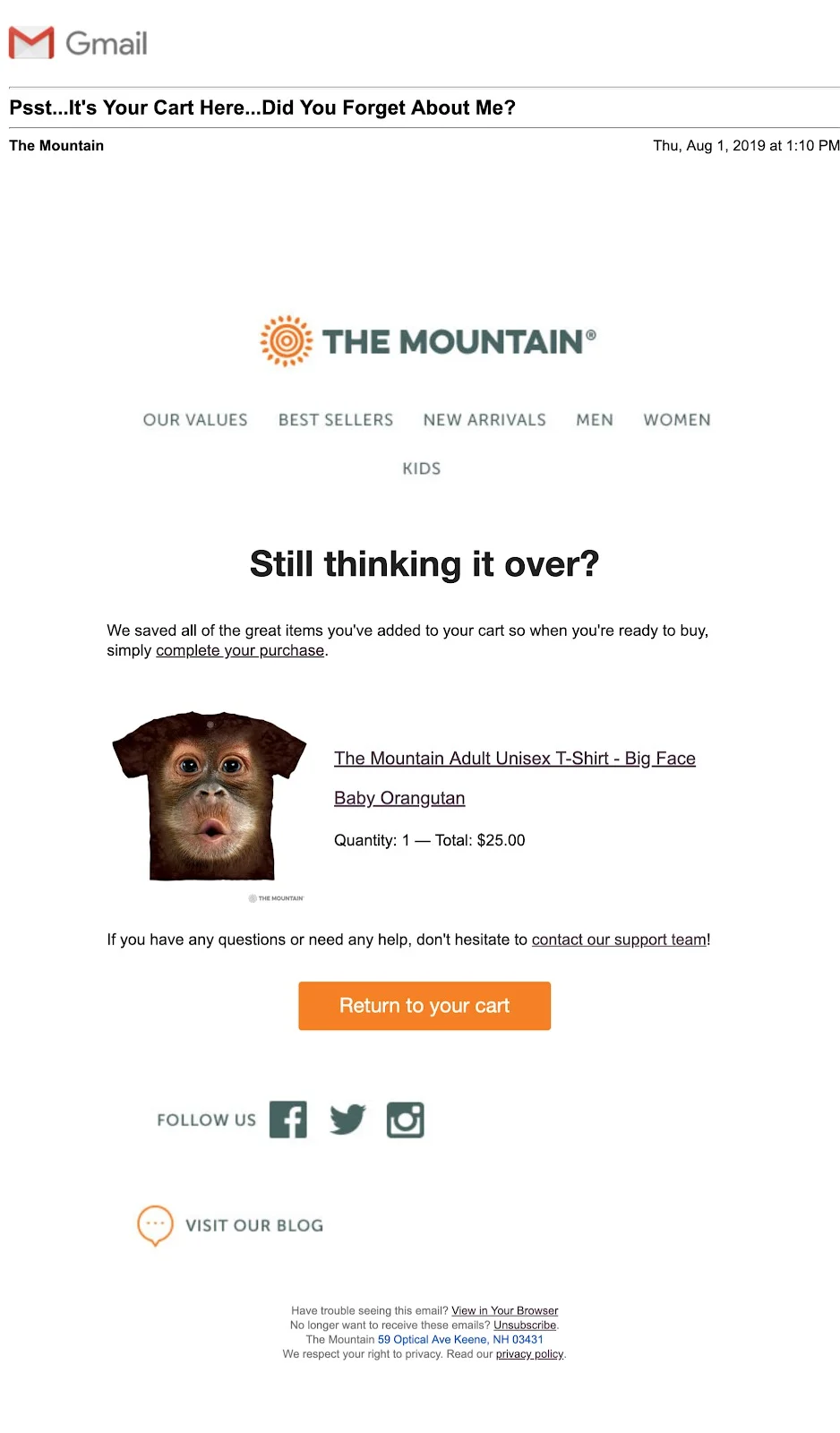
4. AuthenTEAK
AuthenTEAK sells luxury patio furniture, grills, and accessories that help people create beautiful outdoor living spaces they can enjoy year round. I added four throw pillows to my cart after browsing around their site, and then I received an email with the following subject line.
It looks like you left something behind…
This is another example of a well-written subject line. It’s straight to the point, it focuses on one message, yet it teases the reader a bit by making them wonder what they forgot. The use of the ellipsis (…) signifies there’s more to the story and is a great way to spark the reader’s curiosity.
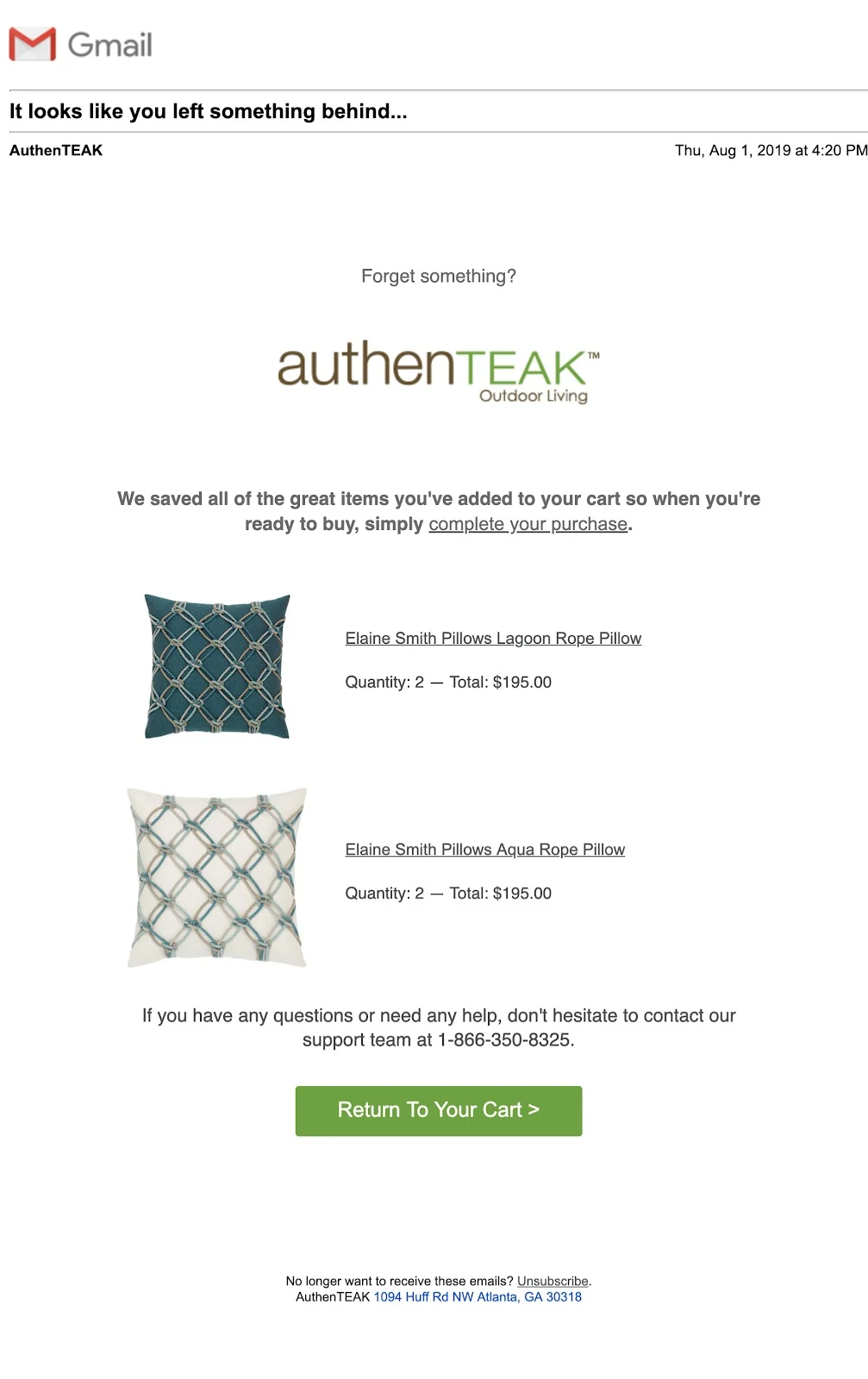
5. KiraGrace
KiraGrace is a designer activewear brand that makes women’s yoga clothing known for its luxurious quality and perfect fit. I spent some time on the brand’s site looking through the different collections and ultimately added a pair of yoga tights to my cart. This is the subject line the brand included in my email:
Still thinking it over?
This subject line is simple, it creates curiosity by using a question mark, and it encourages the reader to remember that they were once interested in the brand’s products.
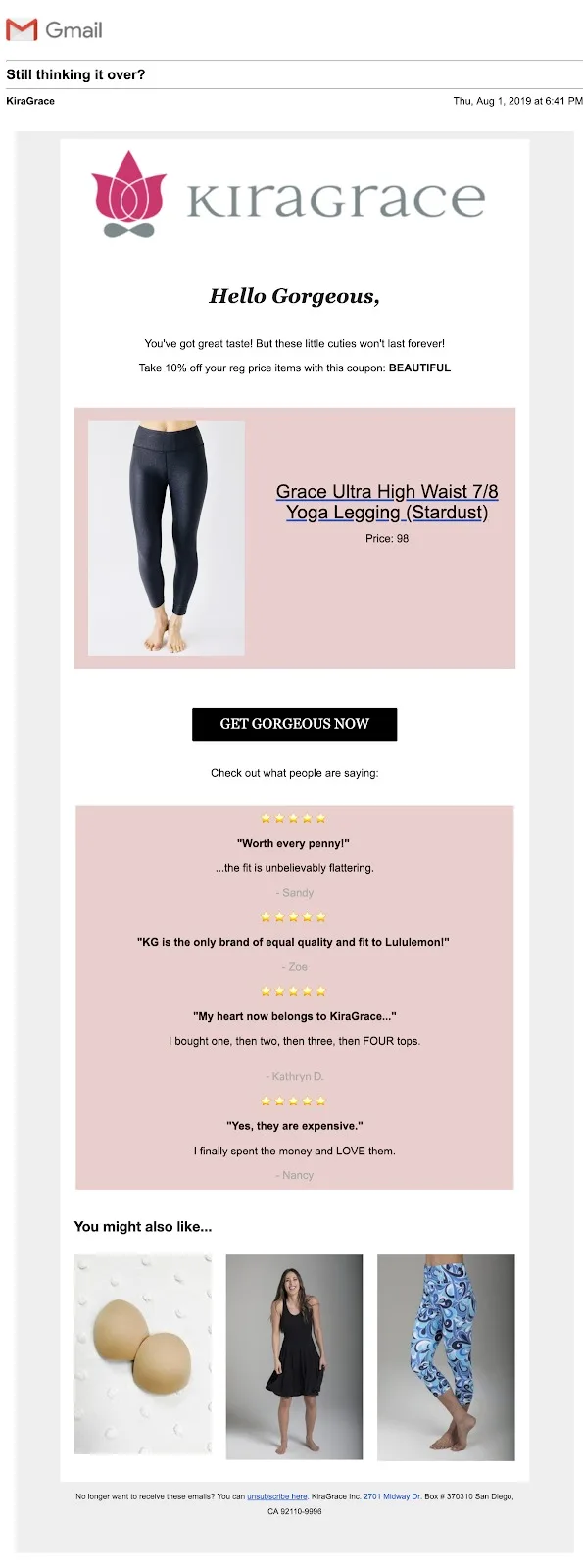
6. Mahogany Smoked Meats
Mahogany Smoked Meats is a California-based meat purveyor that offers a variety of meat products and gourmet gifts. I added a party assortment platter to my cart and received an email with the following subject line:
We don’t want you to miss out…
This subject line creates a sense of potential loss and shows readers they may miss out on something if they don’t act soon. Many people have a fear of missing out, so subject lines like this drive people open their email to see what they might soon miss.
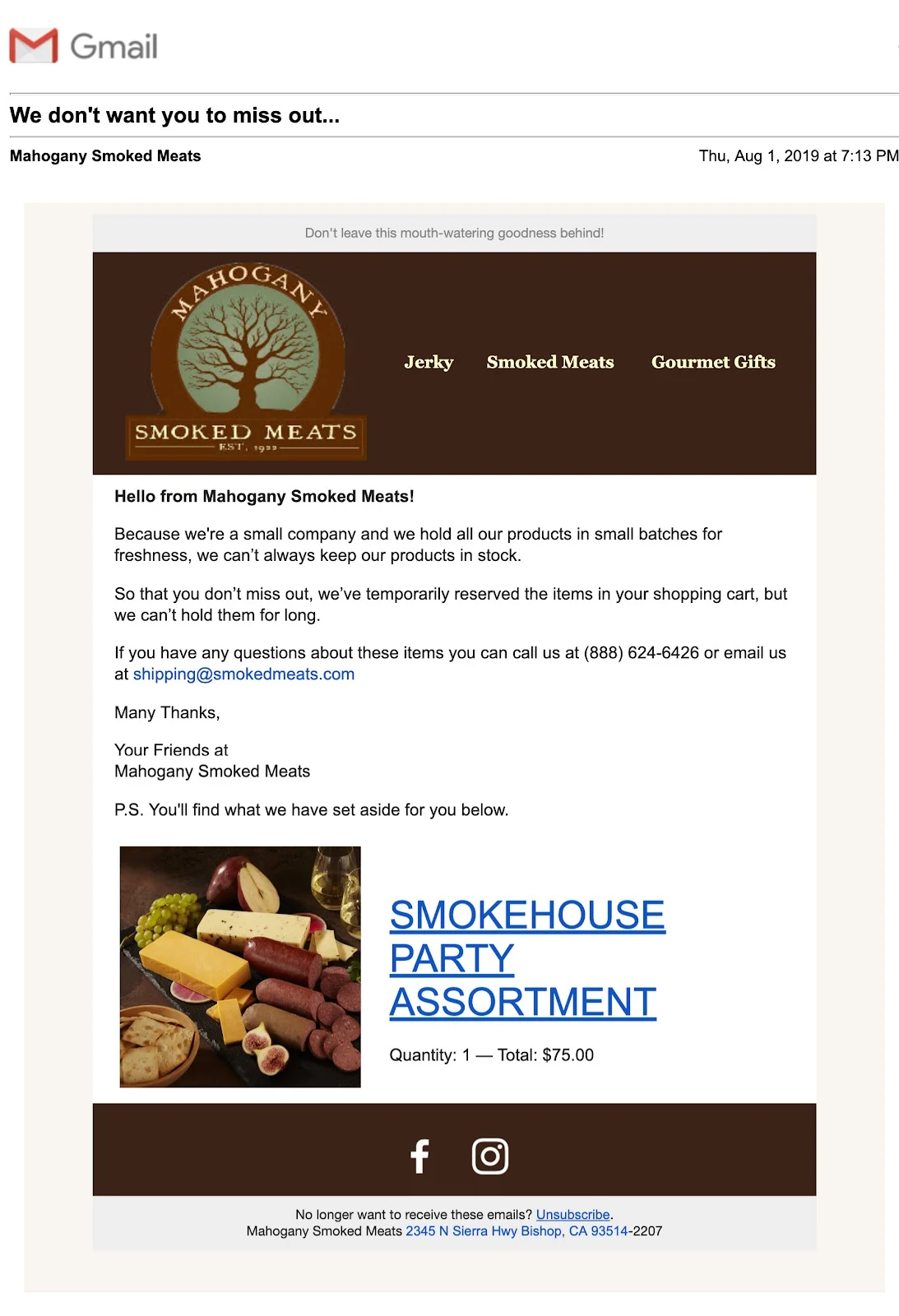
7. Kardiel
Kardiel sells handcrafted modern furniture, home decor, and accessories. I spent some time looking through their collection before adding two bar stools to my cart. This is the subject line that accompanied the abandoned cart email campaign I received:
Your furniture picks are going fast!
This subject line is also intended to create a sense that the reader might miss out on something — specifically, the furniture the reader was previously interested in purchasing — and it conveys a sense of energy through the use of one exclamation point.
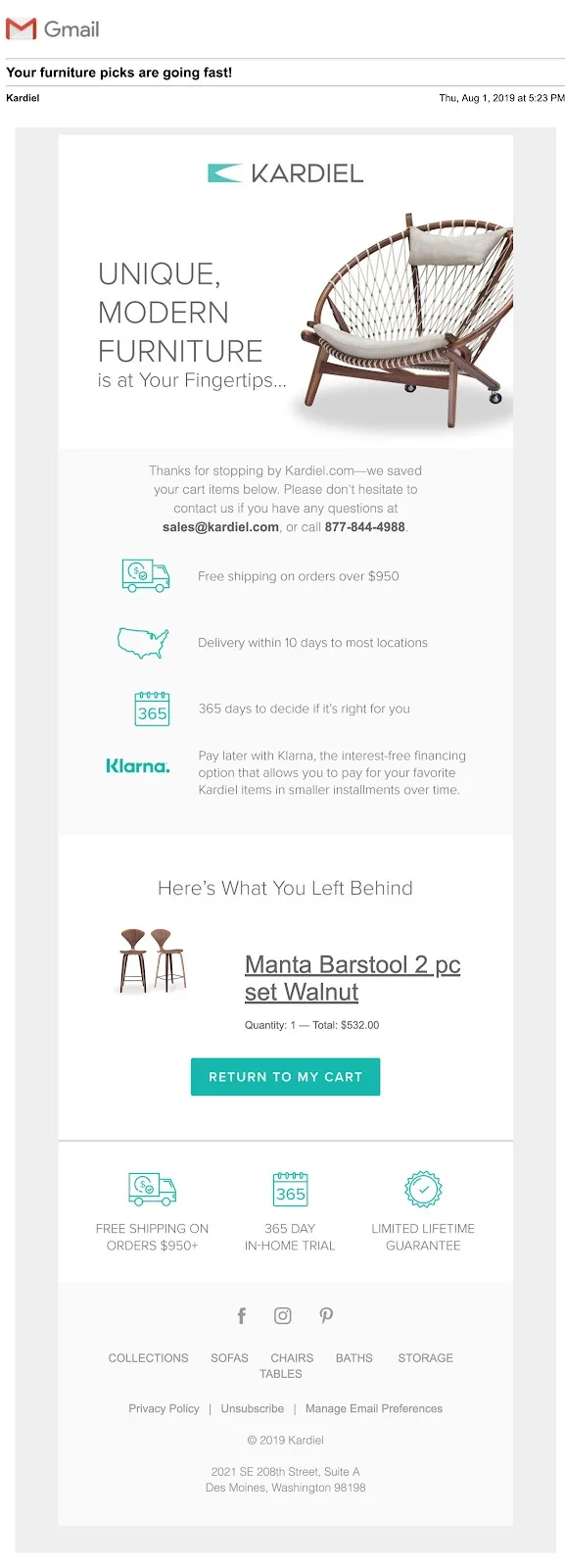
Key Takeaways
There’s an abundance of data that shows abandoned cart emails help brands recover potential lost sales and make more money, so it’s clear why every ecommerce marketer should include a series of abandoned cart emails as part of their email marketing mix.
To get people to open your abandoned cart emails, you can use many different strategies, try all sorts of subject lines, experiment with how you write and style your copy, segment your list so shoppers receive the most relevant messages, and test each experiment to see what works best.
But the bottom line is that every ecommerce business is different.
What works for one brand might not work for another. And what works for your brand today might not work for your brand as you grow.
Take these tips and examples as inspiration, and try some new subject lines you think will resonate well with your customers.
Experiment with them and then test, test, and test again.

Katie Tierney is the Managing Editor at Klaviyo, the growth marketing platform built for online businesses. With more than 15 years’ experience, Katie is a marketer, content strategist, writer, and editor who’s built global content marketing teams for fast-growing SaaS companies and created content for some of the world’s most recognized and respected brands—notably Virgin. Follow Katie on Twitter: @k_tierney.